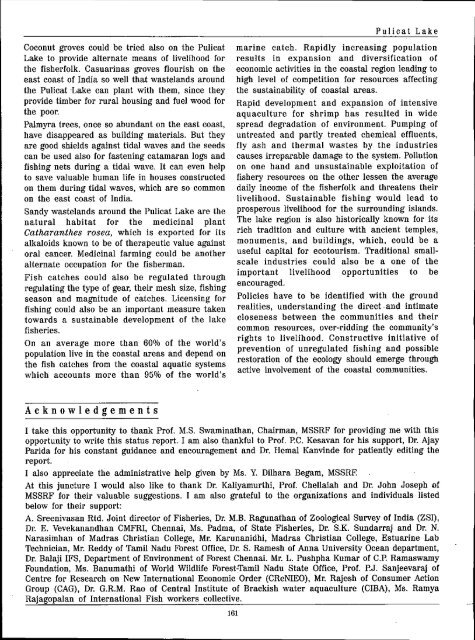06-bioresourcesstatu.. - M. S. Swaminathan Research Foundation
06-bioresourcesstatu.. - M. S. Swaminathan Research Foundation
06-bioresourcesstatu.. - M. S. Swaminathan Research Foundation
You also want an ePaper? Increase the reach of your titles
YUMPU automatically turns print PDFs into web optimized ePapers that Google loves.
Coconut groves could be tried also on the Pulicat<br />
Lake to provide alternate means of livelihood for<br />
the fisherfolk. Casuarinas groves flourish on the<br />
east coast of India so well that wastelands around<br />
the Pulicat -Lake can plant with them, since they<br />
provide timher for rural housing and fuel wood for<br />
the poor.<br />
Palmyra trees, once so ahundant on the east coast,<br />
have disappeared as huildiug materials. But they<br />
are good shields against tidal waves and the seeds<br />
can he used also for fastening catamaran logs and<br />
fishing nets during a tidal wave. It can even help<br />
to save valuable human life in houses constructed<br />
on them during tidal waves, which are so common<br />
on the east coast of India.<br />
Sandy wastelands around the Pulicat Lake are the<br />
natural habitat for the medicinal plant<br />
Catharanthes rosea, which is exported for its<br />
alkaloids known to be of therapeutic value against<br />
oral cancer. Medicinal farming could be another<br />
alternate occupation for the fisherman.<br />
Fish catches could also be regulated through<br />
regulating the type of gear, their mesh size, fishing<br />
season and magnitude of catches. Licensing for<br />
fishing could also be an important measure taken<br />
towards a sustainable development of the lake<br />
fisheries.<br />
On an average more than 60% of the world's<br />
population live in the coastal areas and depend on<br />
the fish catches from the coastal aquatic systems<br />
which accounts more than 95% of the world's<br />
Acknowledgements<br />
Pulicat Lake<br />
marine catch. Rapidly increasing population<br />
results in expansion and diversification of<br />
economic activities in the coastal region leading to<br />
high level of competition for resources affecting<br />
the sustainability of coastal areas.<br />
Rapid development and expansion of intensive<br />
aquaculture for shrimp has resulted in wide<br />
spread degradation of environment. Pumping of<br />
untreated and partly treated chemical effluents,<br />
fly ash and thermal wastes by the industries<br />
causes irreparable damage to the system. Pollution<br />
on one hand and unsustainable exploitation of<br />
fishery resources on the other lessen the average<br />
daily income of the fisherfolk and threatens their<br />
livelihood. Sustainable fishing would lead to<br />
prosperous livelihood for the surrounding islands.<br />
The lake region is also historically known for its<br />
rich tradition and culture with ancient temples,<br />
monuments, and buildings, which, could be a<br />
useful capital for ecotourism. Traditional smallscale<br />
industries could also be a one of the<br />
important livelihood opportunities to be<br />
encouraged.<br />
Policies have to be identified with the ground<br />
realities, understanding the direct and intimate<br />
closeness between the communities and their<br />
common resources, over-ridding the community's<br />
rights to livelihood. Constructive initiative of<br />
prevention of unregulated fishing and possible<br />
restoration of the ecology should emerge through<br />
active involvement of the coastal communities.<br />
I take this opportunity to thank Prof. M.S. <strong>Swaminathan</strong>, Chairman, MSSRF for providing me with this<br />
opportunity to write this status report. I am also thankful to Prof. P.C. Kesavan for his support, Dr. Ajay<br />
Parida for bis constant guidance and encouragement and Dr. Hemal Kanvinde for patiently editing the<br />
report.<br />
I also appreciate the administrative help given by Ms. Y. Dilhara Begam, MSSRF.<br />
At this juncture I would also like to thank Dr. Kaliyamurthi, Prof. Chellaiah and Dr. John Joseph {)f<br />
MSSRF for their valuable suggestions. I am also grateful to the organizations and individuals listed<br />
below for their support:<br />
A. Sreenivasan Rtd. Joint director of Fisheries, Dr. M.B. Ragunathan of Zoological Survey of India (ZSI),<br />
Dr. E. Vevekanandhan CMFRI, Chennai, Ms. Padma, of State Fisheries, Dr. S.K. Sundarraj and Dr. N.<br />
Narasimhan of Madras Christian College, Mr. Karunanidhi, Madras Christian College, Estuarine Lab<br />
Technician, Mr. Reddy of Tamil Nadu Forest Office, Dr. S. Ramesh of Anna University Ocean department,<br />
Dr. Balaji IFS, Department of Environment of Fbrest Chennai. Mr. L. Pushpha Kumar of C.P. Ramaswamy<br />
<strong>Foundation</strong>, Ms. Banumathi of World Wildlife Forest,Tamii Nadu State Office, Prof. P.J. Sanjeevaraj of<br />
Centre for <strong>Research</strong> on New International Economic Order (CReNIEO), Mr. Rajesh of Consumer Action<br />
Group (CAG), Dr. G.R.M. Rao of Central Institute of Brackish water aquaculture (CIBA), Ms. Ramya<br />
Rajagopalan of International Fish workers collective.<br />
161










